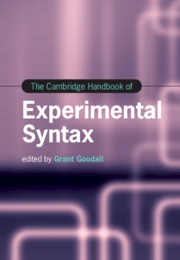Book contents
- The Cambridge Handbook of Experimental Syntax
- The Cambridge Handbook of Experimental Syntax
- Copyright page
- Contents
- Figures
- Tables
- Contributors
- Introduction
- Part I General Issues in Acceptability Experiments
- Part II Experimental Studies of Specific Phenomena
- Part III Experimental Studies of Specific Populations and Language Families
- 14 Acceptability Studies in L2 Populations
- 15 Judgments of Acceptability, Truth, and Felicity in Child Language
- 16 Acceptability and Truth-Value Judgment Studies in East Asian Languages
- 17 Acceptability Experiments in Romance Languages
- 18 Acceptability Studies in (Non-English) Germanic Languages
- 19 Acceptability Studies in Semitic Languages
- 20 Experimental Syntax and Slavic Languages
- 21 Acceptability Judgments in Sign Linguistics
- Part IV Experimental Syntax beyond Acceptability
- Index
- References
16 - Acceptability and Truth-Value Judgment Studies in East Asian Languages
from Part III - Experimental Studies of Specific Populations and Language Families
Published online by Cambridge University Press: 16 December 2021
- The Cambridge Handbook of Experimental Syntax
- The Cambridge Handbook of Experimental Syntax
- Copyright page
- Contents
- Figures
- Tables
- Contributors
- Introduction
- Part I General Issues in Acceptability Experiments
- Part II Experimental Studies of Specific Phenomena
- Part III Experimental Studies of Specific Populations and Language Families
- 14 Acceptability Studies in L2 Populations
- 15 Judgments of Acceptability, Truth, and Felicity in Child Language
- 16 Acceptability and Truth-Value Judgment Studies in East Asian Languages
- 17 Acceptability Experiments in Romance Languages
- 18 Acceptability Studies in (Non-English) Germanic Languages
- 19 Acceptability Studies in Semitic Languages
- 20 Experimental Syntax and Slavic Languages
- 21 Acceptability Judgments in Sign Linguistics
- Part IV Experimental Syntax beyond Acceptability
- Index
- References
Summary
Since the early development of modern syntactic theory, empirical data from three major East Asian languages, Chinese, Japanese, and Korean, have often challenged empirical generalizations and theoretical proposals based on data from the better-studied Indo-European languages, especially English. Experimental syntax also began with studies of phenomena in English and other major Indo-European languages. More recently, however, a growing number of experimental syntactic studies have focused on East Asian languages, especially in the past decade. This chapter highlights three phenomena explored in the rapidly growing body of experimental syntactic research with Chinese, Japanese, and Korean: (i) split intransitivity, (ii) quantifier scope, and (iii) wh-in-situ. The goal of the chapter is to show that, while the literature on East Asian experimental syntax is still at an early stage, it has already accumulated interesting experimental data on syntactic phenomena with important theoretical implications.
Keywords
- Type
- Chapter
- Information
- The Cambridge Handbook of Experimental Syntax , pp. 421 - 447Publisher: Cambridge University PressPrint publication year: 2021



